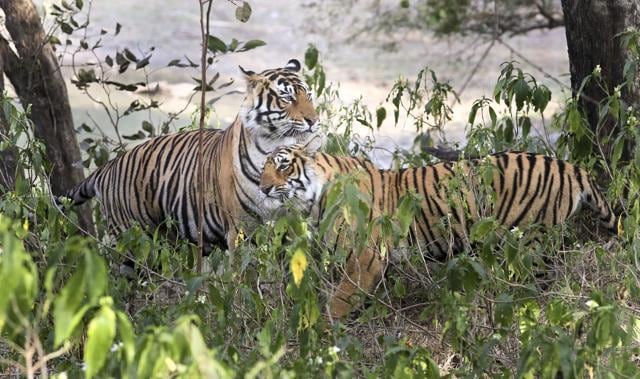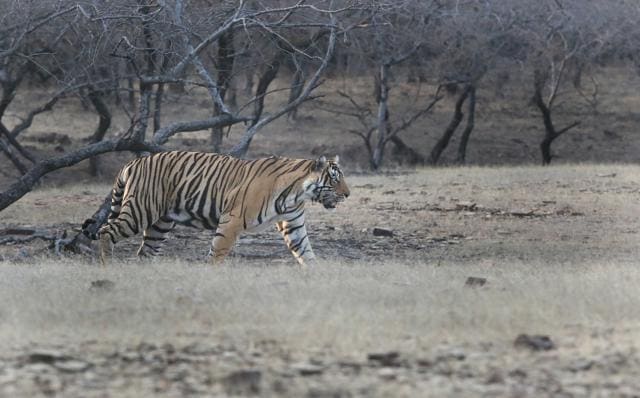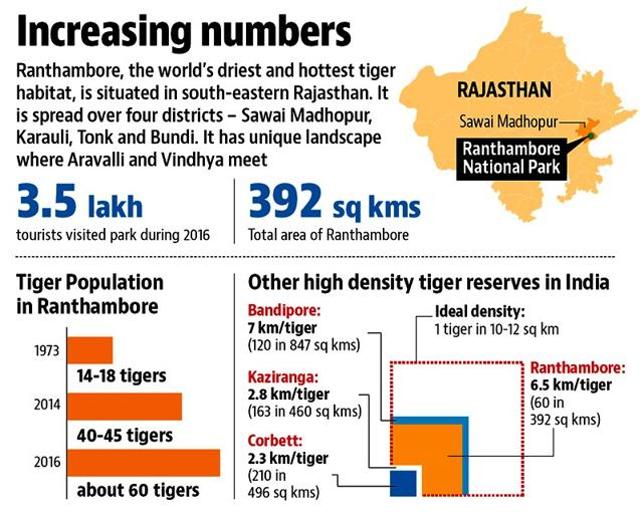With increase in numbers, tigers fight it out for space in Ranthambore reserve
Tiger population has increased over the years but Ranthambore’s capacity to accommodate them remains a concern.
Sisters, Lightening and Arrow Head, cannot stand the sight of each other. In October, 2016 they fought thrice for supremacy in Ranthambore’s lake area, with Arrow Head having the upper hand. Lightening moved to the peripheral area, Amma Ghati.

Territory divided, they still bay for each other’s blood. It’s a war out in the wilderness of Ranthambore where tiger numbers have exploded in the last few years resulting in increasing territorial disputes, which — unlike tiger human conflict — mostly goes unreported.
Normally, a tiger demarcates 10-12 square km as his or her territory not allowing a rival to enter. And when one enters, there is a fight for dominance with the stronger one retaining the region and the weaker pushed to the periphery.
The reserve had just 14-18 tigers when it was among the first tiger habitat to be brought under national protection in 1973.
The number increased to 60 in 2016 with tiger habitat remaining almost the same — 392 square kilometers. It is now the third most densely populated tiger home in India after Corbett in Uttarakhand and Kaziranga in Assam with outward migration of tigers – an indication of the conflict — on the rise.
Most fights in one of the oldest tiger homes of India have been among young adults baying to dominate the richest prey base, the core. Some of these fights have results in the weaker cat getting injured and been pushed out to newer areas.
Forest officials said between 2002 and 2013, six tigers migrated out of Ranthambore to different areas, including Kuno Palpur in Madhya Pradesh, and only one of them returned. Three of them were found dead and two did not return. In recent past, four tigers have moved to Kailadevi, a new green home for Ranthambore animals.

To manage increasing population, the forest department developed adjoining areas Sawai Mansingh and Kailadevi apart from voluntarily relocating villages from Ranthambore.
The Centre also helped by agreeing to notify Mukundra Hills as third tiger reserve in the state.
The other one is Sariska, whose tiger population has been sourced from Ranthamore, as it lost all tigers in 2005. It was only after Sariska that the government swung into action and the whole exercise of conservation was strengthened – effective monitoring and strict action on poaching activities, involvement of the NGOs.
Terming territorial fight as an indicator of good habitat condition for big cats, Ranthambore’s field director Y K Sahu, said, “The present tiger area is not congested, but needs to expand. Surplus animals will move out like the four did to Kailadevi area. That is natural.”
Though such fights are natural for habitats meeting parameters of a good wildlife home, the dramatic change in Ranthambore, that generated 62% of wildlife tourism revenue for Rajasthan, is a mix bag story in wildlife conservation.
Sahu said what has helped Ranthambore is consolidation in relocation of villages, efforts to build prey base and developing grasslands for wildlife.

The gains are visible as Ranthambore’s core area is doing well because of good prey population, but the weaker tigers have to struggle to find their food.
The Kailadevi habitat, where most tigers are moving, does not have enough prey base and quality of green cover to sustain bigger tiger population.
“Tiger is exploring areas, but they return in absence of food and space. Almost all tigers touch boundary as the width is less. We need to develop Kailadevi area for expansion and reduce territorial pressure. The forest department is developing Mukundra tiger reserve, but emphasis should be on Kailadevi,” said conservation biologist Dharmendra Khandal.
Former director Project Tiger P K Sen, however, found some gaping holes in the Rathambore conservation plan saying there was no futuristic planning.

“The Centre had declared Mukundra Hills Tiger as a reserve, but unfortunately there is no corridor in between, whereas the objective behind this exercise was that the spillover goes to Mukundra,” he told Hindustan Times.
Areas adjoining Ranthambore – Kailadevi and Sawai Man Singh sanctuary were not managed intensively like Ranthambore in earlier days till it was brought under Critical Tiger Habitat, he added.
Sen said in another 5-10 years there would be more chances of conflict when the population will be beyond Ranthambore’s carrying capacity. Citing example he said at Corbett tiger reserve, the quality of forest is good, but there is conflict instances as the population is increasing.
“We can create a corridor, but not territories, as they are chosen by tigers depending on water and prey base,” he said.

Sahu agreed to some extent and suggested that even Kuno sanctuary in Madhya Pradesh should be developed to sustain population. If that happens, it would be first inter-state collaboration to conserve Ranthambore tigers.
Get Current Updates on India News, Lok Sabha Election 2024 live, Infosys Q4 Results Live, Elections 2024, Election 2024 Date along with Latest News and Top Headlines from India and around the world.




